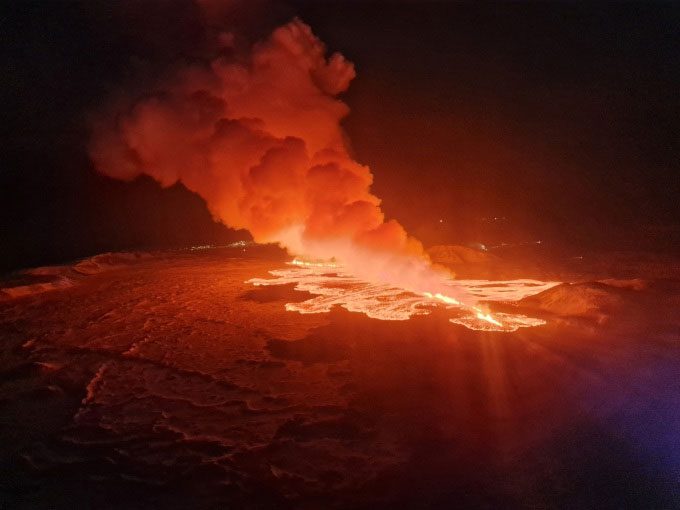A volcanic eruption has occurred on the Reykjanes Peninsula in southwestern Iceland. This event has created a fissure approximately 3 kilometers long on the ground and has ejected lava up to 80 meters into the air.
“At 5:30 AM this morning, intense seismic activity was recorded northeast of Mount Sylingarfell. About 30 minutes later, the volcanic eruption occurred,” announced the Icelandic Meteorological Office (IMO) on February 8.
Live footage from the outskirts of the town of Grindavik shows red-hot lava flowing from a fissure on the mountain, illuminating the smoke rising under the night sky.

Smoke rising and lava flowing from a fissure during the volcanic eruption in the outskirts of Grindavik, Iceland, on February 8. (Photo: AFP).
According to the IMO, based on initial assessments from a Coast Guard flight, the fissure is approximately three kilometers long, releasing lava that erupts between 50 and 80 meters high.
“The lava flow is mainly moving westward and appears to be slightly less than the first eruption on December 18, 2023,” the agency stated.
This eruption is occurring in the same area as two previous eruptions, the first on December 18 last year and the second on January 14, near the coastal town of Grindavik.
In November 2023, Grindavik had to evacuate residents after hundreds of consecutive earthquakes damaged buildings and caused significant cracks in the roads.
Two volcanic fissures formed during the second eruption, one of which appeared right at the edge of the town, causing lava to flow onto the roads, destroying three homes.
Seismologist Kristin Jonsdottir commented that the location of the latest eruption is north of Grindavik and far from infrastructure. He considers this fortunate.
Situated between the Eurasian and North American tectonic plates, two of the largest tectonic plates on the planet, Iceland is a hotspot for seismic and volcanic activity, as these plates move away from each other.
In 2010, a cloud of ash from the eruption of Eyafjallajokull in southern Iceland spread across much of Europe, causing about 100,000 flight cancellations and forcing hundreds of Icelanders to evacuate. Unlike Eyafjallajokull, the Reykjanes volcanic system is not located beneath glaciers, so it is not expected to produce similar ash clouds.



















































